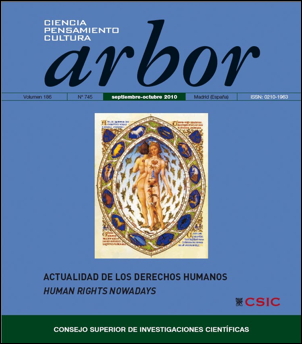Microscopes of the 18th Century in the Natural Science Museum. Csic. Two Unique Pieces from the Enlightenment Period for the Naturalistic Research
DOI:
https://doi.org/10.3989/arbor.2010.745n12acKeywords:
Industrial archeology, history, characteristics, restoration, microscopes, eighteenth century, George Adams, D. Antonio de Ulloa, D. Pedro Franco Dávila, Dollond, D. Eugenio IzquierdoAbstract
The objective of this work is to make a journey the history, characteristics and process of restoring of two of the oldest pieces in the Collection of the Technology and Industrial Archeology from the National Museum of Natural Sciences. CSIC. They are two microscopes from the eighteenth century, built in England. The simple-compound microscope, built by George Adams around 1750-1770, might have belonged to Don Antonio de Ulloa or Don Pedro Franco Dávila. Only two similar pieces are displayed in the Science Museum in Geneva and London. The compound microscope, built by Dollond in the 1780s, was owned by Eugenio Izquierdo de Rivera y Lazaún successor of D. Pedro Franco Dávila in the direction of the Royal Cabinet of Natural History. He was a well-known naturalist as well as a judge, diplomat, secretary and informant of Manuel Godoy.
Downloads
References
Adams, G. (1771): Micrographia Illustrata, or, the Knowledge of the Microscope Explain’s together with an account of a new invented universal, singles on double, microscope. The Fourth Edition. London.
Barreiro, A. J. (1992): El Museo Nacional de Ciencias Naturales (1771-1935). Edición de P. M. Sánchez Moreno. Ediciones Doce Calles. Madrid.
Bolaños, M.ª (1997): Historia de los museos en España. Memoria, cultura y sociedad. Trea. Gijón.
Calatayud, M.ª A. (1987): Catálogo de documentos del Real Gabinete de Historia Natural (1752-1786). CSIC. Madrid.
Calatayud, M.ª A. (1988): Pedro Franco Dávila, primer director del Real Gabinete de Historia Natural fundado por Carlos III. CSIC. Museo Nacional de Ciencias Naturales. Madrid.
Calatayud, M.ª A. (2009): Eugenio Izquierdo de Rivera y Lazaún (1745-1813) científico y político en la sombra. Monografías Museo Nacional de Ciencias Naturales. CSIC. Madrid.
Gaya Nuño, J. A. (1955): Historia y guía de los museos de España. Espasa Calpe, S.A. Madrid (Segunda Ed. 1969).
González-Alcalde, J. (1999): “La nueva ley de Patrimonio Histórico de la Comunidad de Madrid: deber de conservación y responsabilidad con nuestros bienes culturales”. Comunidad Madrileña, 2.ª quincena de enero, año VIII. Madrid.
González-Alcalde, J. (2002): “Una reflexión pedagógica sobre nuestro patrimonio arqueológico”. Actas del Primer Simposio de Arqueología de Guadalajara. Sigüenza. Guadalajara, 4-7 de octubre de 2000, vol. 2. Homenaje a Encarnación Cabré Herreros. Ernesto García-Soto Mateos y Miguel Ángel García Valero (Editores). Imprenta Laguna, S.A.L. Madrid: 669-674.
González-Alcalde, J. (2002-2003): “Una reflexión sobre la Ley de Patrimonio Histórico de la Comunidad de Madrid: deber de salvaguardia y responsabilidad con nuestra herencia cultural”. Estudios de Prehistoria y Arqueología Madrileñas, 13: 199.
González-Alcalde, J. (2008 a): “Arqueología de los Instrumentos Científicos”. Periódico del Museo Nacional de Ciencias Naturales, n.º 7, julio-septiembre: 8-9.
González-Alcalde, J. (2008 b): “Microscopio compuesto y caja de caoba con instrumentos”. Catálogo de la Exposición: España 1808-1814. De súbditos a ciudadanos: 97.
González-Alcalde, J. (2010): “Microscopio simple-compuesto”. Catálogo de la Exposición: El mar no tiene dioses. Homenaje a José Emilio Pacheco. Premio Cervantes 2009: 90-91).
González-Alcalde, J.; Sáez-Dégano, J. A. (2009): “La colección de instrumentos científicos del MNCN, restaurada”. Periódico del Museo Nacional de Ciencias Naturales, n.º 8, extraordinario, enero/marzo: 10.
Hernández Hernández, F. (1994): Manual de Museología. Edit. Síntesis. Madrid.
Holbrook, M. (1992): “Science Preserved”. Science Museum. London: 56, fig. 82.
Important Clock, Watches, Wrist Watches, Barometers Mechanical, Musical Instruments & Instruments of Science and Tecnology (1995): Catálogo de la subasta celebrada en Sotheby’s de Londres los días 2 y 3 de marzo: 174, fig. 722.
Moreno, R.; Romero, A. y Redrajo, F. (1995): La recuperación de la instrumentación científico-histórica del CSIC. El Museo Nacional de Ciencias Naturales. Original mecanografíado.
Moreno, R.; Romero, A. y Redrajo, F. (1996): “La recuperación de la instrumentación científico-histórica del Consejo Superior de Investigaciones Científicas”. Arbor, CLIII: 9-54.
Sanz Pastor, C. (1990): Museos y colecciones de España. Ministerio de Cultura. Madrid.
Turner, A. (1987): Early Scientific Instrument. Europe 1400-1800. Sotheby’s Publications. London: 118.
Villena, M.; Almazán, J. S.; Muñoz, J. y Yagüe, F. (2008): El gabinete perdido. Pedro Franco Dávila y la historia natural del siglo de las luces. CSIC.
Downloads
Published
How to Cite
Issue
Section
License
Copyright (c) 2010 Consejo Superior de Investigaciones Científicas (CSIC)

This work is licensed under a Creative Commons Attribution 4.0 International License.
© CSIC. Manuscripts published in both the printed and online versions of this Journal are the property of Consejo Superior de Investigaciones Científicas, and quoting this source is a requirement for any partial or full reproduction.All contents of this electronic edition, except where otherwise noted, are distributed under a “Creative Commons Attribution 4.0 International” (CC BY 4.0) License. You may read here the basic information and the legal text of the license. The indication of the CC BY 4.0 License must be expressly stated in this way when necessary.
Self-archiving in repositories, personal webpages or similar, of any version other than the published by the Editor, is not allowed.














